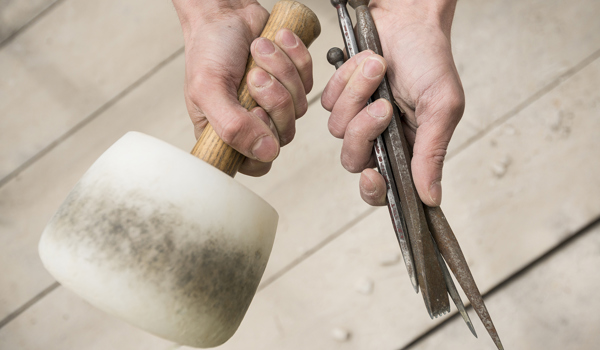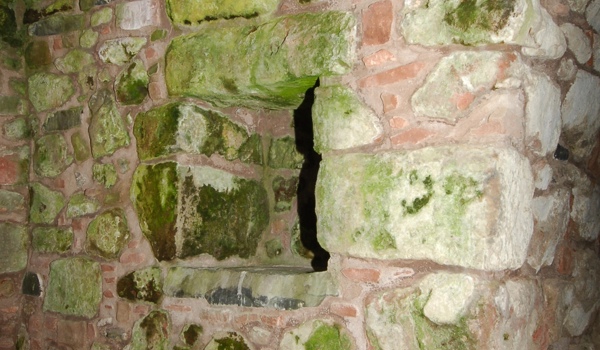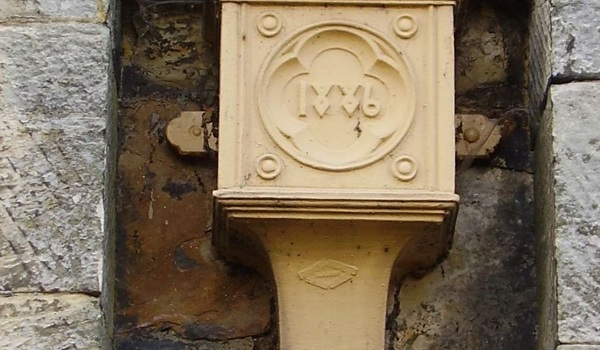- Home
- Building Advice
- Building components
- Cast iron rain goods
Cast iron rain goods
Overview
Overview
Rainwater goods do the vital job of carrying water away from a building to prevent it from entering the fabric or running down the walls.
Rhones (gutters) and downpipes, which are traditionally made of cast iron, carry rainwater from the roof. Neglecting this system, or its various parts, can be disastrous. Poorly functioning rainwater goods are often directly responsible for serious internal and external deterioration and costly repairs.
Regular inspections of rainwater goods will help to avoid serious issues. As well as an annual check of the system, you should regularly clear rainwater goods, gullies and drains of plant growth, leaves and debris. Be especially vigilant in autumn or after a storm, and always investigate any signs of leaks urgently.
Blockages and plant growth, fractures, corrosion, misaligned components and inappropriate repairs are common causes of problems with rainwater goods.
Original cast iron rainwater goods should continue to perform as effectively as they’ve always done with proper maintenance and repairs. A regular maintenance programme is the most effective way to prevent problems.
Replacing failed cast iron rainwater goods with cheaper alternatives spoils the look of a traditional building and is usually a false economy.
Update your personalised ad preferences to view content
- Next
-
Characteristics
Characteristics
Characteristics
Rhones (gutters) and downpipes carry rainwater from the roof, helping to keep a traditional building dry.
Rainwater goods are generally made from cast iron, which is strong and hard but also brittle – it will shatter if struck by a sharp blow.
Leaf guards may be fitted to gutters, and wire balloons placed over the tops of downpipes, to help reduce blockages caused by leaves or other debris.
- Previous
-
Overview
- Next
-
Inspection
Inspection
Inspection
Rhones (gutters) and downpipes should be regularly checked for debris and blockages. Be especially vigilant in autumn or after a storm. Any leaves or other matter should be cleared from rhones. Choked downpipes may need to be dismantled by an experienced contractor.
Joints between the lengths of rhone should also be sound and watertight. Rust marks will often signal where a leak is developing.
Check that downpipes are secured to the masonry with proper fastenings or brackets. Stained or damp masonry can be a sign of failed roof drainage.
Initial inspection
Check rainwater goods from outside, standing at ground level. Follow the line of the rhones and downpipes for signs of staining, damp, rust or eroded masonry nearby. Using binoculars may help you to see rainwater goods more clearly.
You should also check inside for signs of leaks or further damage. Such signs may not be obvious from the outside but may point to external problems with rhones and downpipes.
Check inside for:
- damp patches on walls and ceilings
- damp and mouldy plasterwork on walls and ceilings
- decay of timber skirting boards and panelling
- dry rot in structural and concealed timber
- a musty smelling odour caused by dampness in rooms
Note down any concerns or signs of problems to discuss with the contractor who will carry out the repair work.
Roof-level inspection
Rainwater goods should be closely inspected for any areas of deterioration or damage. It's also good to check that rhones and hoppers (the large buckets at the top of downpipes) are big enough to do their job properly.
Your contractor should look for signs of:
- plant or algae growth
- eroded mortar joints
- eroded masonry
- damp staining to walls behind or beneath rainwater goods
- saturation of masonry, brickwork or render
- local failure of render
- wet rot in external joinery
- staining on walls caused by run-off from rainwater goods
It's wise to also check at ground level for damage to foundations or the build up of water in drains.
- Previous
-
Characteristics
- Next
-
Common causes of problems
Common causes of problems
Common causes of problems
Many significant structural problems stem from the failure to maintain and repair rainwater goods. If any single element fails, large volumes of water may pour into walls, spreading downwards and outwards.
Rhones (gutters) and downpipes can be difficult to access and so aren’t always inspected as often as they should be. But it’s vital for the well-being of your property that all rainwater goods work effectively.
Blockages and plant growth
Build up of leaves and other debris can block rhones and downpipes, gullies and drains. Blockages lead to water overflowing and leaking into the building through the roof or walls.
Downpipe shoes (the curved base) and swan-necked (curved) sections are most at risk. Blockages to gullies and drains can cause flooding at the base of walls, often resulting in rising damp.
Excess water encourages plant growth, which further blocks the disposal of water. All parapet gutters (gutters hidden behind a parapet) and rhones and downpipes should be regularly cleared out.
Fractures
Trapped water can freeze, causing rhones and downpipes to fracture as the ice expands. On thawing, the water will leak through the crack.
Corrosion
Cast iron rainwater goods are at risk from corrosion if not painted fully or often enough. This can go unnoticed for some time, especially in hard-to-reach areas such as the rear of rhones. Badly sealed, leaking joints are most prone to further corrosion.
Misaligned components
Rhones and downpipes may leak if they're out of line. Loose fixings or broken sections are usually to blame. Joints in cast iron rainwater goods should be sealed with a flexible jointing compound to allow a little movement.
Missing or damaged fixings should be replaced before the rhone and downpipe sections become dislodged. Avoid rhones being broken by the pressure of ladders placed against them – position ladders against the wall instead.
Inappropriate repairs and replacements
Aluminium, mild steel and plastic are unsuitable materials to replace cast iron rainwater goods. They spoil the look of a traditional building and have a shorter lifespan. Money saved in the short term will be cancelled out by the need to renew inferior replacements earlier than if using cast iron versions.
Other repair work to avoid:
- repairs using unsuitable metals or fixings – these may speed up corrosion due to the galvanic reaction
- welding using the wrong materials and methods – this can damage the performance and look of cast iron
- undersized replacement rhones and downpipes – these can lead to overflows and leaks
- Previous
-
Inspection
- Next
-
Maintenance and repairs
Maintenance and repairs
Maintenance and repairs
Original cast iron rainwater goods should continue to perform as effectively as they’ve always done if properly cared for.
Maintenance programme
A regular maintenance programme is the most effective way to prevent common causes of problems with rhones (gutters) and downpipes.
You should:
- inspect rainwater goods every year – remember, some problems may only be visible in heavy rain
- immediately investigate any signs of leaks or water getting into the building
- regularly clear rainwater goods, gullies and drains of plant growth, leaves and debris – be especially vigilant in autumn or after a storm
Leaf guards can be fitted to gutters, and wire balloons placed over the tops of rhones (downpipes) to help reduce blockages. But these will also need to be checked regularly checks to prevent a build up of debris.
Reuse vs replacement
It’s best to retain as much of the original building fabric as possible. But cast iron can be difficult to fix and welding repairs don’t always last. Cast iron welding should only be carried out off site and by experienced craftspeople.
You should aim to replace only those components that are missing or beyond repair. Gutter outlets can tell you where missing rhones were originally located. Existing fixings should be reused wherever possible.
Replacing ‘like for like’
Replacement sections should match existing in:
- size
- profile
- appearance
You can source replacements from foundries specialising in traditional casting. It’s usually possible to match original designs. Plain castings are available from most builders’ merchants.
Replacement downpipes should be fixed away from the wall to allow:
- repainting to the rear
- any leaking water to run down the back of the pipe rather than down the wall
Painting
Cast iron rainwater goods should be periodically painted.
Before painting:
- fill small holes to prevent water seeping in and getting trapped
- reseal defective gutter joints with a flexible jointing compound
- remove rust with a wire brush and sandpaper – never just paint over it
- clean the surface of dirt and grease
- roughen existing paint with sandpaper to help the new paint stick to it
- make sure the modern paint you plan to use is compatible with the original paint – check with the paint manufacturer if in doubt
Hard-to-reach areas such as the rear of rhones should be painted as far as possible.
Prepare new castings using two coats of a zinc-based primer followed by one coat of micaceous iron oxide. Finish with two coats of gloss paint.
- Previous
-
Common causes of problems
- Next
-
Permissions for work
Permissions for work
Permissions for work
You should check whether you must first apply for planning permission or any other type of consent before making any changes to rainwater goods. Listed building consent or conservation area consent may be needed, depending on the property and its location. Contact your planning authority to find out more.
Learn more about listed building and conservation area consent.
- Previous
-
Maintenance and repairs
- Next
-
History
History
History
Rainwater goods form part of a traditional building’s architecture and styling. Parapet gutters and projecting details were used to clear or throw water from a building. Later, a system of rhones (gutters) and downpipes attached to the building structure was developed.
Materials used to make rainwater goods have included timber, stone, lead, zinc, copper and iron.
Cast iron production
First a pattern is made, usually of wood. This is then used to make a mould using special sand. Molten iron is then poured into the mould and left to set.
Rainwater goods were costly to manufacture, so their use was limited mainly to high status buildings until the 1800s. Mass production began at this time, making rainwater goods much more affordable and their use widespread.
Cast iron’s versatility also meant it was a popular means for adding decoration to a building. Hopper heads were often ornate, and decoration was sometimes added to rhones and to downpipe brackets.
Scotland’s cast iron manufacturers were world leaders in the production of cast iron items in the 19th century. Their illustrated catalogues featured large ranges of goods. A wide variety of hopper head, gutter and gutter bracket designs still survive. It’s often possible to identify the original manufacturer by the marks they made on their products.
- Previous
-
Permissions for work
- Next
-
Contacts
Contacts
Contacts
Get in touch if you have any questions. We will be happy to help.
- Technical Research Team
- 0131 668 8951
- technicalresearch@hes.scot
- Previous
-
History
- Next
-
Resources
Resources
Resources
Professional institutions
Cast Metal Federation
Metal Gutter Manufacturers Association
The National Federation of Roofing Contractors
Confederation of Roofing Contractors
The Institute of Roofing
Publications
Inform guides
An introduction to conservation and maintenance of traditional buildings for complete beginners.
The Maintenance of Cast Iron Rainwater Goods
Short guides
Information on building conservation topics for home owners, trades people and building professionals.
4 – Maintenance and Repair Techniques for Traditional Cast Iron
Other resources
- Previous
-
Contacts

Hiring a contractor
Get advice on hiring a contractor including choosing a contractor and managing the work.




